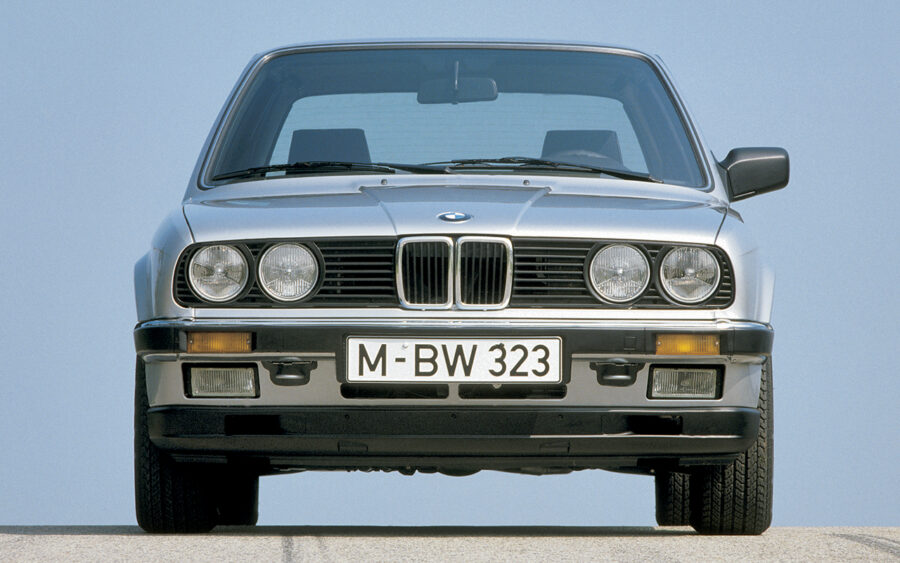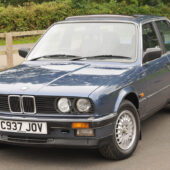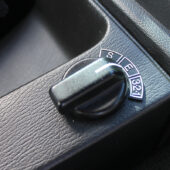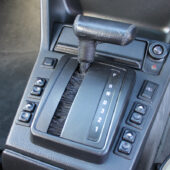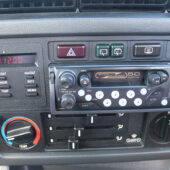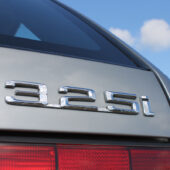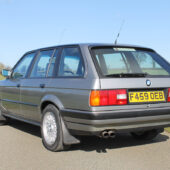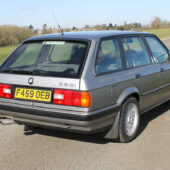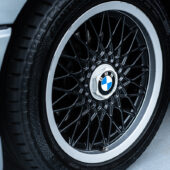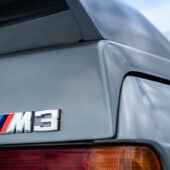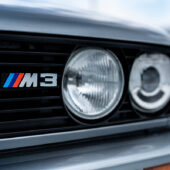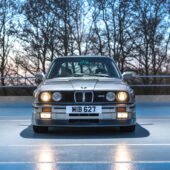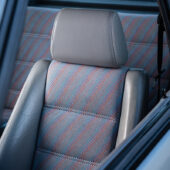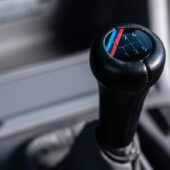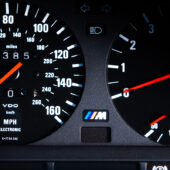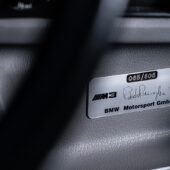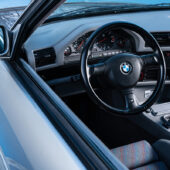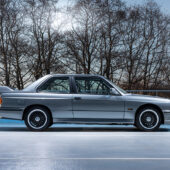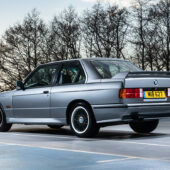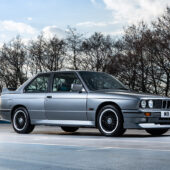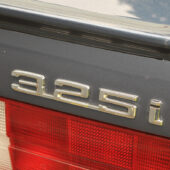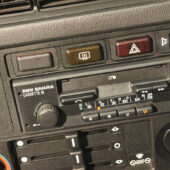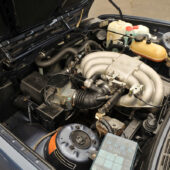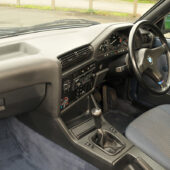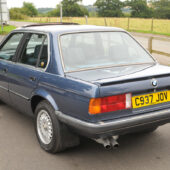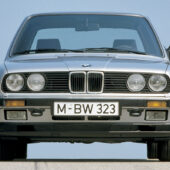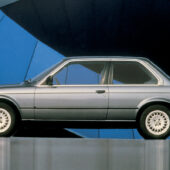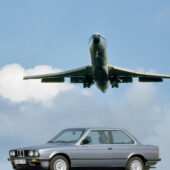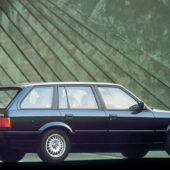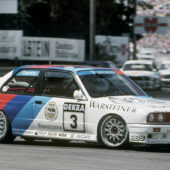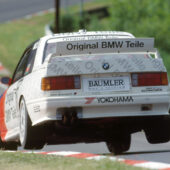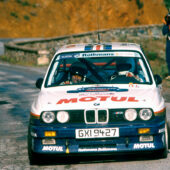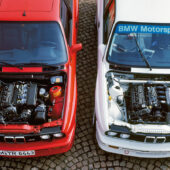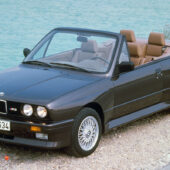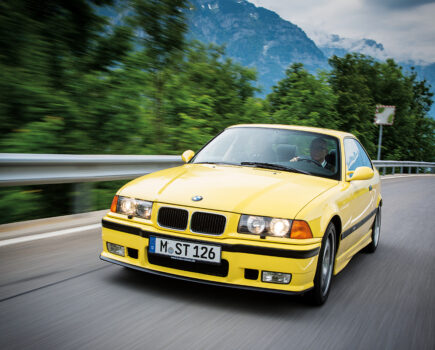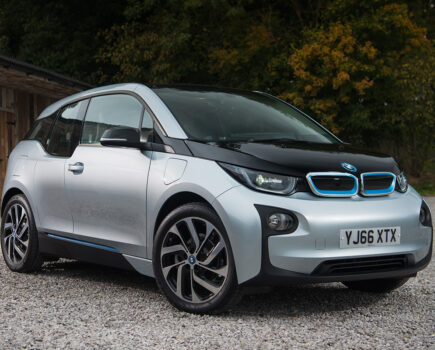Yuppie cool, motorsport tool: the E30 3 Series was long-lived, surprisingly versatile – and extremely popular. Here’s the full story
Words: Jon Burgess Images: BMW, CCA, Iconic Auctioneers, Bonhams, James Howe, Paul Wager
BMW knew it was on to something with the E21 3 Series – but its failings were manifold and well documented. Incremental improvements in technology, body rigidity, aerodynamics and refinement would see its successor, the E30, succeed beyond the wildest dreams of the first 3 Series.
Careful evolution produced a winner, with quad headlights: one that the upwardly mobile recognised as a status symbol, while sating the keen driver sensible enough to want a small car, but mature enough to cope with rear-wheel drive.
Paul Bracq was succeeded by Claus Luthe in shaping the new car, which was to be slightly larger and heavier than its predecessor. Computer aided design improved rigidity – and careful upgrades to the semi-trailing arm rear suspension rid the E30 of the worst of the E21’s snap oversteer tendencies.
As work began on the E30 in 1976, designer Hans Braun joined BMW following a stint at Porsche Design; his leadership provided the E30 with a driver-focused interior unlike any BMW had made before. A key motif of Braun’s E30 cabin, the barrel or drum air vent, became a staple of modern car design, appearing across the industry in cars as downmarket and as disparate as the 1993 Vauxhall/Opel Corsa.
Key to the E30’s appeal among the upwardly mobile was its versatility. Unlike the E21, which remained a two-door saloon throughout its life, the E30 offered two- and four-door models from launch in 1982, inheriting the E21’s M10 four- and M20 six-cylinder engines. The block of former unit, would serve the carburetted 316; modified (M12/M13/Megatron), it would take F1 cars to record-breaking speeds and power the seminal E30 M3.
The M20 ‘little six’ carried on into the E30 without much modification, though Bosch LE-Jetronic fuel injection replaced K-Jet on the 323i.
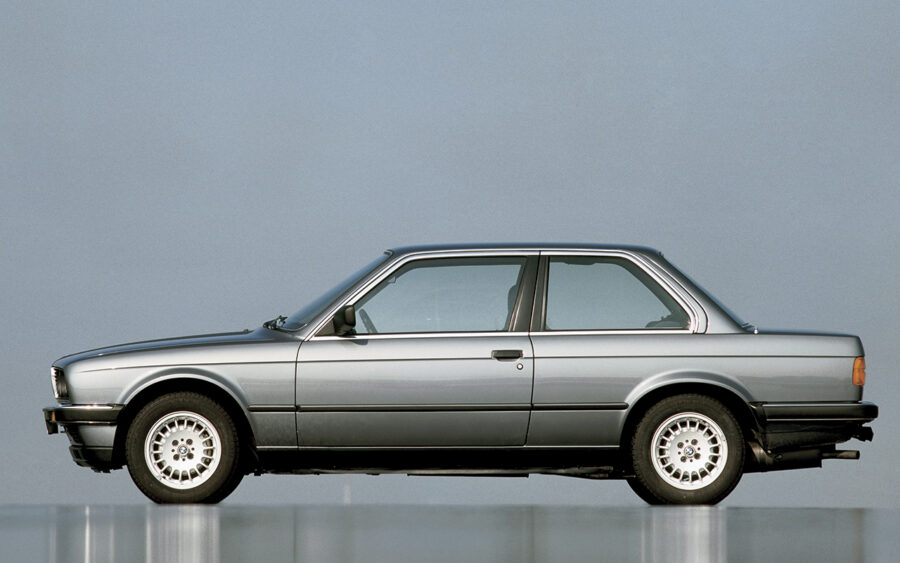
There was more to come in a soon-to-be glittering career that would encompass a number of 3 Series firsts, offering diesel models (324d and td), an all-wheel-drive option (BMW’s first as a company) the first ‘Dreier’ Touring, and a full Convertible (the E21 was converted by Karosserie Baur in Stuttgart). BMW realised the earning potential in keeping these options (and the customers that came with them) in house.
UK buyers didn’t get their hands on the E30 until March 1983, with four-door sales following that November. Praise was swift, quickly recognising the suspension improvements, driver-focused cabin, and new Getrag five-speed manual gearbox. The six-pot 320i and 323i could also be had with an optional four-speed automatic, the now-ubiquitous ZF 4HP22 stepping up to the plate.
1983 also saw production of the E30 begin at Plant Rosslyn, South Africa. Established in the 1960s, this factory would carry on making subsequent iterations of the 3 Series until 2018, when the X3 took over. BMW South Africa enjoyed a surprising amount of autonomy and a strong relationship with tuner Alpina; in time, Rosslyn’s 333i, 325iS and 325iS Performance HP would leave their own mark on the E30’s legacy.
Karosserie Baur created its first open E30s in 1983; the TC2 (Top Convertible 2) used a targa-style frame to hold the canvas roof in place, and remained the only open-air E30 available until a full Convertible was announced three years later.
The United States finally received its E30s in 1984, crowned by a special fuel saving variant of the M20 ‘little six’ known as the 325e, for eta, the Greek letter used to indicate thermal efficiency. In fact, this new unit displaced 2.7-litres; as supplied, it made 124bhp, but in later years, its block was used by Alpina.
There was even an E30 Touring on the way – but its origins were quite unlike those of any other 3 Series. There had been no estate hatchback variant of a small BMW since the 2002 Touring left production in 1974; the E21 had only been sold as a two-door saloon.
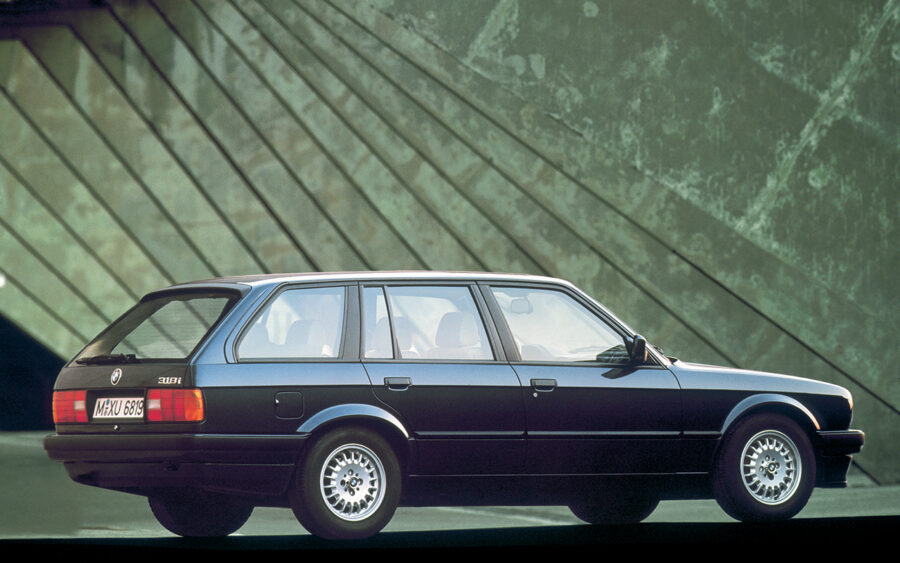
BMW prototype engineer, Max Reisböck, however, had other ideas. With a growing family and a limited budget, he envisioned a hatch back E30 estate, based on a four-door 3 Series.
Having purchased a high-mileage 323i, he wheeled it into a friend’s garage and set to work, painfully aware of the consequences should a BMW manager spot his work. Contractually, body modifications to any BMW were forbidden without express permission; working by hand, with no drawings, Reisböck finished the first-E30-Touring-in-all-but-name some time in 1984, using a VW Passat tailgate glass for the rear hatch.
Upon seeing the car, management were more than enthusiastic: surprised and hitherto unaware, but keen, nonetheless. Reisböck was stunned when he was told BMW was to productionise his design – but his new family car had to disappear. Paid for his clandestine out-of-hours consultancy service, the five-door E30 Touring entered production in 1987.
Unbeknownst to Reisböck or BMW, another E30 estate was also in the offing. Dutch accident repair and bodywork specialists, Luchjenbroers, decided to create its own three-door E30 Sports Combi, using a two-door 323i as its basis, with a VW Golf Mk1 tailgate at the rear. Fully certified for road use, the busy brothers of Luchjenbroers eventually produced three other Sports Combis, the final car converted from a right-hand-drive 3 Series.
If the E30’s rise to fame had thrown up a few surprises to date, 1985 put the past two years to shame. It was the last full year of chromed bumper tops and window surrounds; a minor facelift improved trim and simplified exterior panels to improve aerodynamics.
There was the first 3 Series diesel, too: the M21-engined, naturally-aspirated, six-cylinder 324d, two generations before a compression-ignition ‘Dreier’ would command middle management cred. It didn’t come to the UK, but the scene had been set.

The same year, the M20B23 2.3-litre 323i bowed out in favour of the 2.5-litre, 171bhp M20B25 325i, a new model which gradually chipped away at the powertrain legacy of the E21, though the M10 ‘fours’ had a considerable career still ahead of them.
Said 2.5-litre engine arrived just in time to be slotted into a proper factory convertible, previewed at IAA Frankfurt; Karosserie Baur continued to offer its TC2 conversion programme to any E30 saloon until the end of production – every variant, including some Alpinas, were beheaded. Baur was also responsible for the only true E30 coupe; while two-door cars are incorrectly referred to as such, they remained saloons.
Working with a large dealership network, known as Autohaus Kohl, in Aachen, Germany, the Baur-Kohl Coupe was born, defined by its massive, steeply raked rear window. Picture it as a TC2 with glass replacing the Targa-style hood frame and cartridge, and you get the idea. Accounts differ as to how many were built; between three and four seems to be the consensus.
More surprises were in the pipeline: looking to broaden the appeal of the 325i even further, an all-wheel-drive 325iX was announced – perfect for the upwardly mobile to carry on to their second homes or chalets in winter without changing vehicles.
Marketed on its traction rather than its performance (BMW was not building an HF Integrale rival), the appeal of the 325iX was perhaps overstated, with approximately 15,000 sold during the E30’s total production of more than two million units. Alpina, dutiful as ever, based its C2 ALLRAD on the 325iX. Alpina made the most of the new ‘3er’: its C1, C2, B3 and B6 were all spun off the E30.
Of course, BMW had motorsport ambitions beyond that of what the E21 achieved – and with an eye on homologating the E30 for the German Touring Car Championship (and FISA’s Group A categories) another model took to the floor of the IAA in Frankfurt: the M3, of which 5000 were slated for production, as per the rules.

Capacity and demand fuelled by rave reviews soon saw this figure abandoned; by the time the M3 left catalogues in 1990, 17,970 had been produced, including all three Evolution models.
BMW’s M Division (BMW M GmbH) kept only the bonnet and roof unaltered from standard E30 shell: aerodynamic efficiency was the aim of the game. The boot lid was raised by 40mm, to which a large spoiler was attached; the angle of the rear screen and C-pillar was altered and the windscreen bonded for a flusher fit.
Tweaks were also made to the front air dam and splitter, as well as the sill skirts and rear apron attached to the bumper. Making these parts together with the boot lid and spoiler from Sheet Moulding Composite (SMC) pared off the pounds reducing the drag coefficient down from a dismal 0.38 Cd to 0.33.
Larger wheels and tyres were needed for circuit racing, so the M3’s front and rear wings were flared, further augmenting the M3’s appearance. Suspension was changed further from the E30 to take advantage of the rule book; offset control arm bushes allowed for more caster angle, while the control arms themselves were aluminium, stirred by a rack quicker than any other model of E30. Wheel bearings came from the heavier E28 5-Series, and the E30’s four-bolt stud pattern changed from 4x100mm to 5x120mm.
Then, there was the engine – the double overhead cam 2.3-litre S14, with 195bhp. Based on the humble M10 four-pot, this engine had serious pedigree, tracing its roots back to Alex von Falkenhausen’s 1.5-litre Neue Klasse unit. It drove through a Getrag 265 five-speed gearbox with a dog-leg first for Europe; later Japanese and US-specification cars used a standard H-pattern.
The S14’s designer, engineer Paul Rosche, had quite the CV when it came to high-revving, naturally aspirated engines; having conceived the M1’s 3.5-litre M88, BMW’s first DOHC powerplant, he would later create the 6.1-litre S70/2 V12 for McLaren’s F1.

That the M3 caused a stir is an understatement; its significance consumes that of the E30’s career as if staring directly into the sun. Owing to issues of weight distribution and steering rack placement, a right-hand drive M3 was never on the cards; the latter would have necessitated a redesign of the exhaust manifold robbing the engine of between 15-20bhp.
Rumours continue to this day online of a one-off right hooker E30 M3 built by BMW as a proof of concept; what is certain is that British marque specialist, Birds, converted around 70 cars during the M3’s lifespan.
The UK – like most other selected markets – received their first M3s in 1986, though customers in the United States would have to wait another two years. Other right-hand drive markets, like South Africa and New Zealand, weren’t so lucky: there were to be no M3s sold there, regardless of where the steering wheel happened to be.
Denied the M3, BMW South Africa set out on a path of its own, supported by Alpina. Rosslyn needed a fast E30 of its own to meet the requirements of Group 1 racing, against the likes of the Alfa GTV and Ford Sierra XR8 – and the 197bhp, 204-unit 333i was the result, using a 325i as its basis. BMW SA Motorsport often found unusual solutions to problems; it had previously produced a pair of 745i E23 touring cars, one of them to international Group A race specification.
For the 333i, BMW SA called on Alpina’s expertise to fit the 3.2-litre M30B32 ‘big six’ seen previously in the 533i, 633CSi and 733i into the E30’s engine bay; the boys from Buchloe would crane a 3.5-litre M30 into their own M3-based B6 3.5 from 1986. What’s more, the operation had the blessing of the M Division in Germany.
Regardless of displacement, the ‘big six’ was a tight fit inside the E30, meaning customers had to choose between air-conditioning or power steering (there was only enough space for one or the other).
Alpina supplied BMW SA with specially designed inlet and exhaust manifolds, a heavy duty radiator and larger diameter front discs; a close ratio Getrag dog leg five-speed box, special Bilstein dampers, 16-inch Alpina wheels, and a limited slip ZF differential completed the mechanical overhaul.
1986-onward 333is also received the M-Tech I bumper and side skirt add-ons – a much desired option package encompassing aggressive bodywork addenda, mechanical upgrades and trim pieces, such as leather steering wheels, seats and gear knobs.
For that extra something, the 333i also received red instrument needles (an M3-only feature compared to the white needles of other E30s) and special Alpina gauge clusters for speed and temperature.
Said M Tech I (and later M Tech II) catalogues were the next best thing to an M3: they quickly became an essential tool with which to attract the hearts and minds of keen drivers whose budget and luck simply couldn’t put an M3 on the drive – but could stretch to a 325i.
While the well-to-do were content with the smaller-engined 316 and ‘small six’ 320i models, middle-management and aspirant boy racers flocked to the 325i. Small, prestigious rear-wheel-drive saloons were in short supply in South Africa, with many manufacturers offering hot hatches instead. Alfa persisted with the GTV, but the Ford Sierra XR8 was a larger car again, and appealed to a different sort of performance car enthusiast.
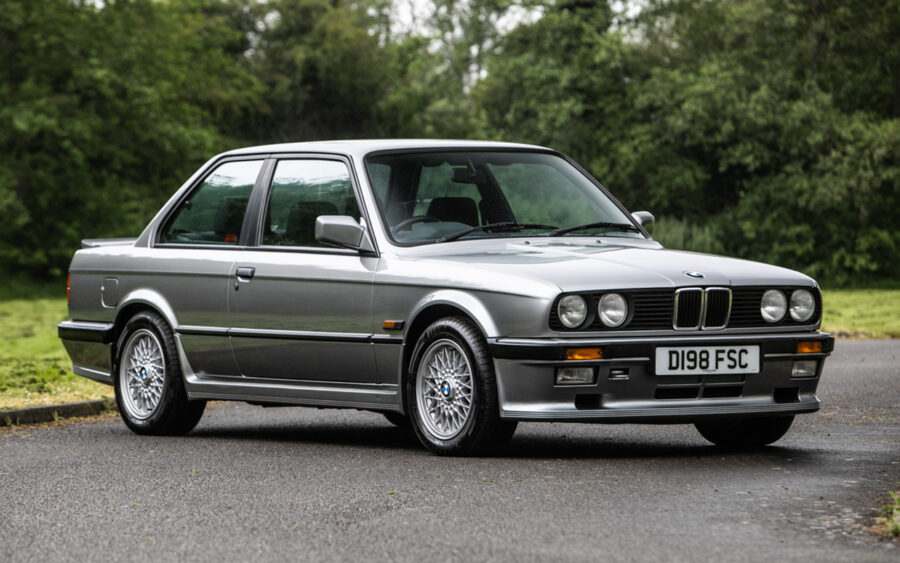
BMW 325i Sport M-Tech
The 325i had long been desirable in the UK, but the 1986-onwards M-Tech catalogue, which added body styling, mechanical and interior upgrades, made it nigh-on irresistible. Witness also the birth of the 325i Sport: arriving in late 1986, it was similar in specification (if chosen) to the 100-unit M325i sold in New Zealand.
If the funds were available, stiffened, 15mm lowered 325is, with close ratio gearboxes, limited slip differentials and BBS cross-spoke alloys were easier and cheaper to come by than an M3, even though its lesser performance, softer suspension and slower steering rack meant it very much played second fiddle to the M Division’s baby.
A further hierarchy was established with the UK’s SE trim level, available for the 320i and 325i, should desire outstrip the budget for a 325i Sport, customised as it was with M-Tech options. Special Equipment cars were designated as such on their registration documents, giving customers colour coded bumpers, and electric sunroofs or rear windows, bridging the gap between the stingily equipped 325i and plusher 325i Sport.
Unlike the Sport, the SE options could be applied to any body style of E30, two-, four-, or Touring five-door; the 325i Sport remained a two-door saloon. Picking the SE option also meant that customers could dip into the M-Tech I (1986-1987) or M-Tech II (1988-1989) mechanical equipment list to as much or as little as their budget could stand, though few 320is carried much in the way of mechanical upgrades.
That other left-hand drive only E30, the 325iX, also went on sale in the UK, though 12 were converted to right hookers; there was also the 325i Convertible, if unlimited headroom was needed.
1987 brought a major facelift: plastic bumpers, bigger tail lights, reshaped rear arches and rear valance, a new front apron and ellipsoid headlights completed the transformation, along with improved rust protection. Max Reisböck’s Touring went into production for Europe; it would be another year before the UK received the model.
In Europe, the six-pot diesel M21 received a turbocharger, creating the 324td. While the E21 had dabbled with forced induction (in the guise of Paul Rosche’s M12-powered 320i Turbo) it was the first time greater-than-atmospheric aspiration had used compression ignition under the bonnet of a 3 Series. Mass adoption was some time off, however; it would take two successive generations of ‘3er’ to make good on the 324d and 324td’s potential.
The M3 began to assert its dominance in touring car racing, winning titles in the World Touring Car Championship, European Touring Car Championship, Italia Superturismo Championship, Deutsche Tourenwagen Meisterschaft, Australian Touring Car Championship, AMSCAR Series and Japanese Touring Car Championship, as well as the Spa 24 Hours, the latter feat it would repeat three more times (in 1988, 1990 and 1992), to say nothing of the five 24 Hours Nürburgring victories (1989, 1990, 1991, 1992 and 1994).
It was rather less successful as a rally car, though an early win on the 1987 Tour de Corse added to the trophy cabinet; while it struggled on loose surfaces against a growing number of all-wheel-drive competitors, the M3 returned the favour on asphalt, winning the 1990 Irish Tarmac Rally Championship with Bertie Fisher and Rory Kennedy.
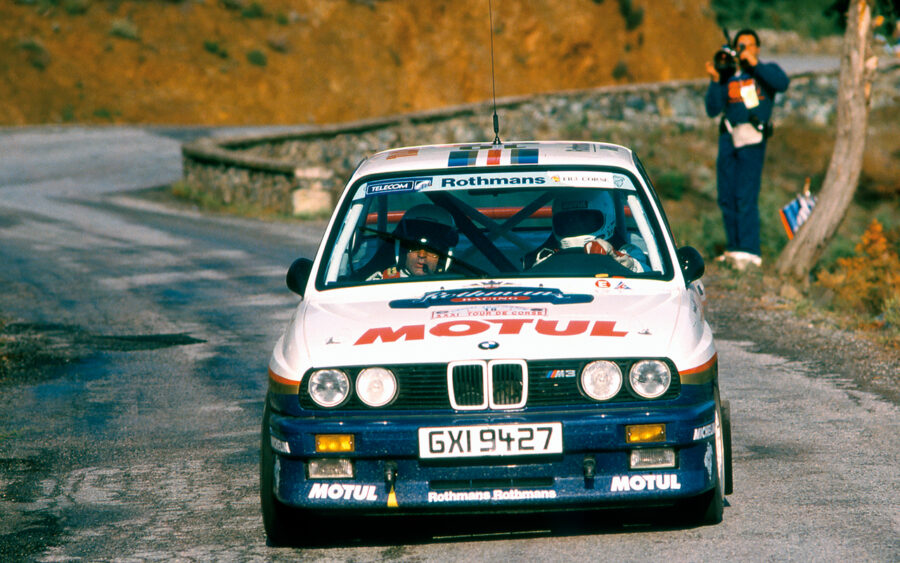
BMW M3 Group A competing in the Tour de Course in 1987
A more radical road-going M3 took to the roads in 1987, too: 215bhp was extracted from the 2.3-litre S14 for the 505-unit ‘Evolution 1’; meanwhile, in Buchloe, Alpina dispensed with the S14 altogether, commencing production of a ‘big six’ M30 version of the M3 known as the B6 3.5S.
That wasn’t the last time the S14 was altered; far from it. A very special variant of the M3 appeared in 1987, known as the 320iS. Built specifically for the Italian and Portuguese markets and their punitive tax legislation, which heavily penalised cars over 2.0-litres, Paul Rosche de-stroked his 2.3-litre down to size. The 1990cc engine which resulted saved buyers a hefty four figure sum in tax compared to an M3 bought new in either country.
With a 72.6mm stroke (versus 84mm) of the standard M3, a new, screaming S14 was born. With intake and exhaust manifolds heavily inspired by those of the Group A rally cars, individual throttle plates, machined intake and exhaust ports, and an eight counterweight crankshaft, the ‘small M3’ or ‘Italo M3’ produced just 3bhp short of a standard 2.3-litre S14 engine. It was 15 lb/ft down on torque, but the weight difference more than made up for the slight performance shortfall.
The 320iS used a standard E30 two- or four-door body shell compared to that of the SMC-enhanced M3; even with four doors, the 320iS was nearly 110kg lighter, making for a car that understeered less.
While it did without the wider track and uprated suspension of the M3, the 320iS used a dogleg Getrag five-speed gearbox, and a shorter final drive. Highly prized by collectors, the 320iS remained a fascinating footnote in the annals of E30 history.
It wouldn’t be the last time an ‘iS’ suffix would be used in deference to the M3, either: the United States got its own version of the 325i Sport, badged in the former for 1987, as did Belgian and French customers – though their 325iSs arrived in 1988, and were carefully optioned 325is created by the importer who had been biding their time until enough short ratio gearboxes arrived.
The M20B25’s journey hadn’t finished yet: the newly formed BMW Technik think-tank unveiled the so-powered Z1 roadster at 1987’s IAA Frankfurt: based on E30 components, but with its own unique self-supporting monocoque, polyester and polycarbonate plastic panels, and a newly developed rear ‘Z-axle’, destined for future 3-Series models. The Z1’s retractable doors, which motored in and out of the sills, wowed visitors; BMW was inundated with deposits.
Sadly, the Z1 spelled the end for another E30-based sports car: Karosserie Baur’s TC3, which remained a fascinating one-off. A bespoke bodied two-seater co-developed with Isdera’s Eberhard Schulz, it fell by the wayside, a casualty of the Z1 programme which had been ongoing since 1985. M Technik decided that the last thing its baby needed was competition from a officially sanctioned coachbuilder.
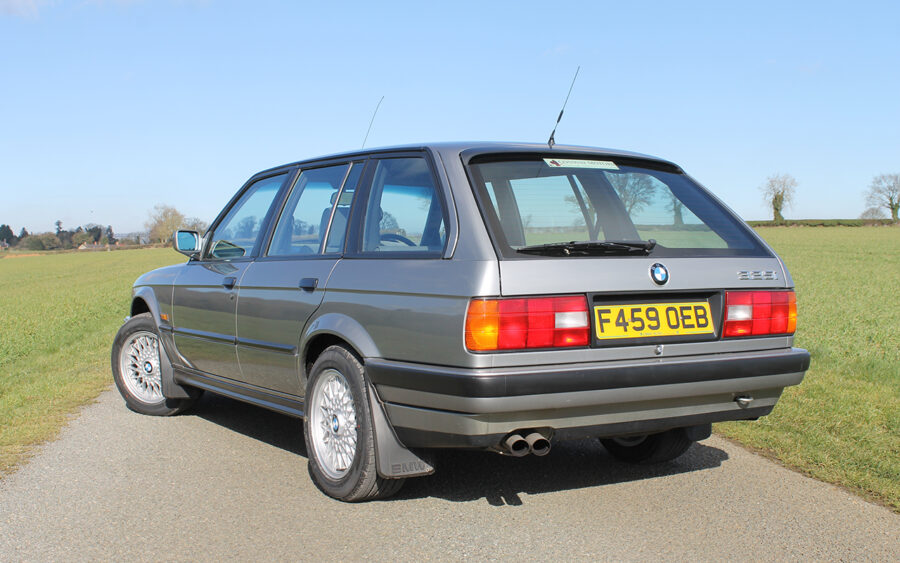
BMW 325i Touring
1988 saw the arrival of the Touring in the UK, to the delight of BMW dealers. The Touring couldn’t hope to compete with serious estate cars on space, but its perceived style and hatchback practicality won it plenty of friends; of course, it could be had with the now-ubiquitous M20B25, with the other engines available to suit a wider range of budgets. The E30 was increasingly viewed as an attainable luxury car, even if buyers stretching their funds had to forego performance and equipment to take a 316i or 318i home.
Long neglected, the run-of-the-mill four-pot M10 range finally received some attention. A year prior, alongside upgraded fuel injection for the six-pot cars, the 318i got a new engine, in the form of the belt-driven M40. Now, it was the 316’s turn: the carburetted M10 was discontinued in favour of another M40, this time displacing 1596cc.
More changes on the M3 front: a limited run of Convertibles began, accompanied by the compression ratio hiked, 220bhp, 1988-only, 501-unit Evolution II, as well as the first of several special editions commemorating touring car wins – the Europa Meister ’88, named in honour of the titular championship victory.
By October, the much-awaited Z1 had gone on sale; waiting lists kept building, and production would eventually be extended, as M Technik got to grips with building a car way outside of BMW’s usual production remit.
As touring car podium finishes mounted for the M3, the road cars began to get quicker. Production of the 195bhp cars were run down, and the 215bhp unit gradually took over. Two more limited series cars models were revealed: the 25-unit Roberto Ravaglia Edition and 480-car Jonny Cecotto Edition.
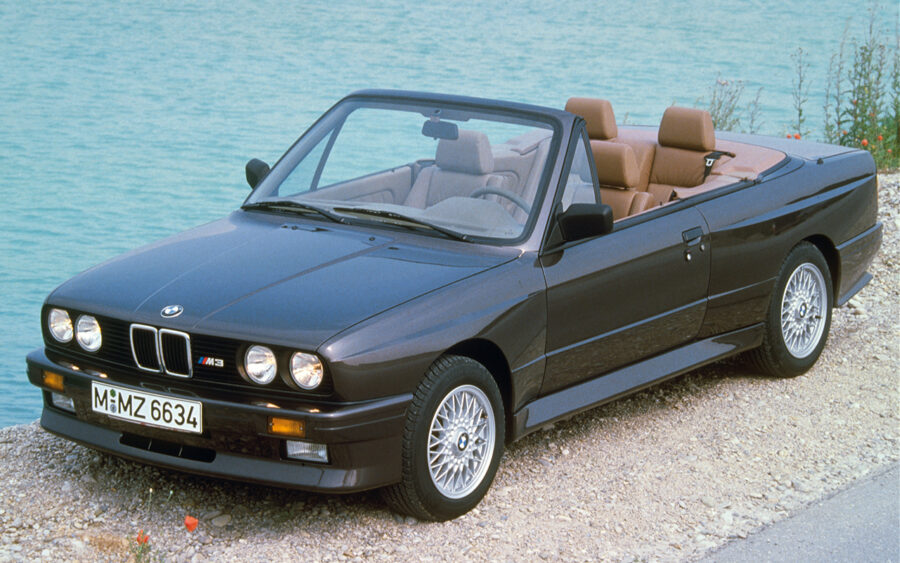
BMW M3 Convertible
Using the deeper front bumper and altered spoiler of the Evolution II, and its larger-than-standard 16 x 7-inch wheels, those same colours were made available to customers, with the rocker covers sprayed to match. They were the first European M3s to use catalytic converters, which would soon be standardised.
There was more news to come for four-cylinder E30 fans: for 1989, a 16v 318i, the 318iS, was joining the range, tilted directly at the VW Golf GTi 16v. Powered by the new chain-driven M42, the 142bhp 318iS wouldn’t come to the UK until 1990.
But 1989 had two more surprises left in store. BMW South Africa unveiled its own 325iS, roughly equivalent to a mechanically optioned UK 325i Sport. 1985’s 333i had been a glorious collaborative homologation effort, but that same year, the Group 1 rules had changed, rendering it ineligible to race. That hadn’t stopped the yearning for a quicker, tailor made E30 with which to race across South Africa, however; the Opel Kadett simply couldn’t take all the glory in Stannic Group N.
That December, meanwhile, the 2.5-litre, 235bhp M3 Sport Evolution was unveiled, with production continuing into 1990 as the most extreme variant of the M3. The M Division weren’t the only ones to up the capacity of the S14; over the years, AC Schnitzer and Hartge offered their own 2.5-litre conversions.
The M3 had long fought off more powerful cars trackside, and the Sport Evolution was acknowledgement of the ongoing battery of changes needed to keep it competitive.
Those large steel wings now bulged out even further; to further reduce drag, both front and rear spoilers could be adjusted. Brake ducts in the front bumper ousted fogs, while the 16 x 7-inch BBS wheels from the Evo I and II stayed under the arches.
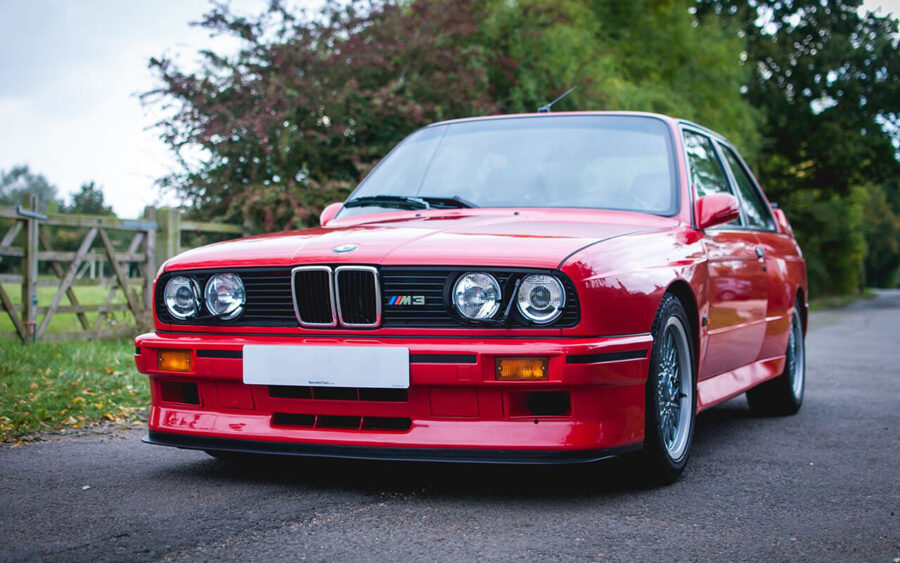
BMW M3 Sport Evolution
Now eight years old, the E30 was slowly being ousted on the production lines. First to go was the M3 Sport Evolution; after 600 units, the last car was completed in March. The new E36 coupe (named as such by BMW) was in pilot assembly by September, and by December, the final catalysed standard M3s were out for delivery, as were the final Z1s.
Not that BMW had abandoned the E30 just yet: British 316i and 318i customers could finally experience the cherry picking of parts and standard fit equipment that six-cylinder SE buyers had enjoyed since late 1986 – except for these cars, the package was called ‘Lux.’
BMW South Africa renewed its technical partnership with Alpina to field a competitor in the Group A category of the Stannic Group N touring car championship, resulting in the 325iS Evolution I.
The car in question was rather more than other nations’ 325iSs, using a 2.7-litre unit of similar specification to that of the Mahle-pistoned Alpina C2/1, while a close-ratio Getrag five-speed ‘box sent the power to a standard limited-slip differential. Lightening was extensive, comprising an aluminium alloy bonnet, door skins and front wings, as well as M3 derived front suspension; an M Tech II body kit was standard.
While adored by press and public alike, BMW SA chased even more power with 1991’s 325iS Performance HP; with the Opel Kadett 16v SuperBoss now a more than credible threat, further work to the M30B27’s exhaust manifold and inlet valves (and a 535i throttle body) yielded 207bhp.
Two years later, Robbie Smith won the SA Stannic Group N Championship in a 325 iS Performance HP, closing the book on an incredible winning streak for the E30 – but not before an M3 won a Japanese Touring Car Championship title the same year, following another 24 Hours Nürburgring victory in 1994.
German production of the two-and four-door saloon E30s ended in 1991, though completely knocked down kit assembly of cars in Indonesia and Thailand continued for a time. While the rest of the E36 range came on stream, the E30 Convertible and Touring held the fort, bowing out in 1993 and 1994 respectively.
The E30 represented BMW at its peak. Seemingly unstoppable, it entrenched BMW firmly in the hearts and minds of the middle classes, winning in the company car park as much as it did on the race track. We will not see its like again.
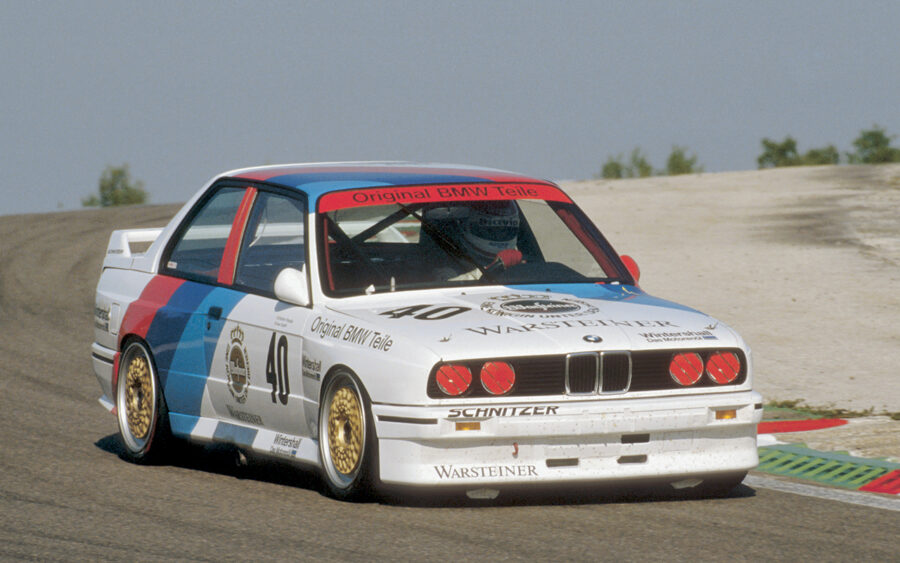
Roberto Ravaglia at the wheel of the M3 at Circuito del Jarama, Spain in 1987
BMW 3 Series (E30) timeline
1976
Work begins on the E30, with design overseen by Claus Luthe; Boyke Boyer assigned to exterior with Hans Braun on interior.
1978-1979
Final designs approved and signed off.
1981
German pilot production of two-door E30 (323i) begins in December.
1982
In January, early pre-production of 320i begins, with 316 production in March; all types in production by October. Model announced officially as a two-door saloon in November, with three models: carburetted 316 (M10), injected 320i (M20) and 323i (M20). Four- and five-speed manuals offered as well as a three-speed automatic.
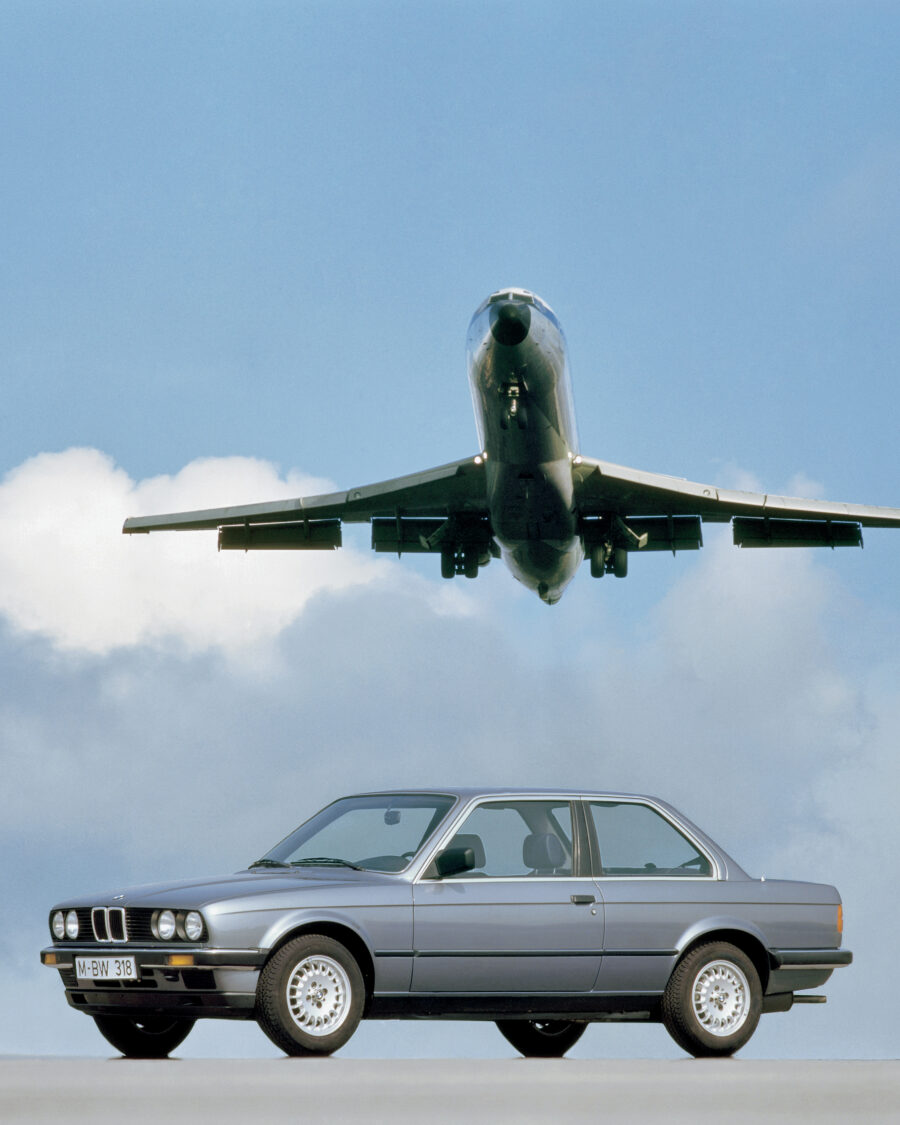
1983
Production of the four-door begins in Germany in January; UK [two-door] sales begin in March; four-door models on sale in Germany in September and in the UK by November. Injected 318i (M10) added to range, 320i and 323i get a four-speed automatic option (ZF 4HP22).
Karosserie Bauer in Stuttgart offers the targa-style Top Cabriolet 2 (TC2) in lieu of an official drophead, offered for any E30 model.
South African production of the E30 begins at Plant Rosslyn.
1984
US E30 sales begin: 318i and 325e (a 127bhp, low-compression, US market specific 2.7-litre) offered as two- and four-door saloons.
BMW engineer, Max Reisböck, begins a self-funded project to create his own Touring from a high-mileage 323i four-door saloon.
Dutch accident repair and bodywork specialists, Luchjenbroers, release its two-door ‘Sport Combi’ estate, as well as a full Convertible.
1985
Mild interior and exterior facelift, including trim options and redesigned bumpers.
M20 2.3-litre straight-six (323i) replaced with M20 2.5-litre (325i) with 171bhp.
Full Convertible, designed with Karosserie Bauer’s help, is previewed at the IAA Frankfurt Motor Show, though sales of TC2s continue.
Motorsport homologation (Group A and German Touring Car) special, left-hand-drive only M3, also shown at Frankfurt IAA. Limited to Europe, 5000 cars originally slated, with this number gradually extended owing to demand. Production of first non-cat M3s begins in July. 2.3-litre S14 four-cylinder engine, 195bhp.
BMW Plant Rosslyn produces its own homologation special: the 197bhp 333i, complete with Alpina-sourced brakes, intake manifold, gauges and wheels [204 units].
All-wheel-drive 325iX shown; in two- and four-door body styles.
Six-cylinder 324d (M21) diesel launched.
True coupe, known as the Baur-Kohl coupe, enters (very) limited production.
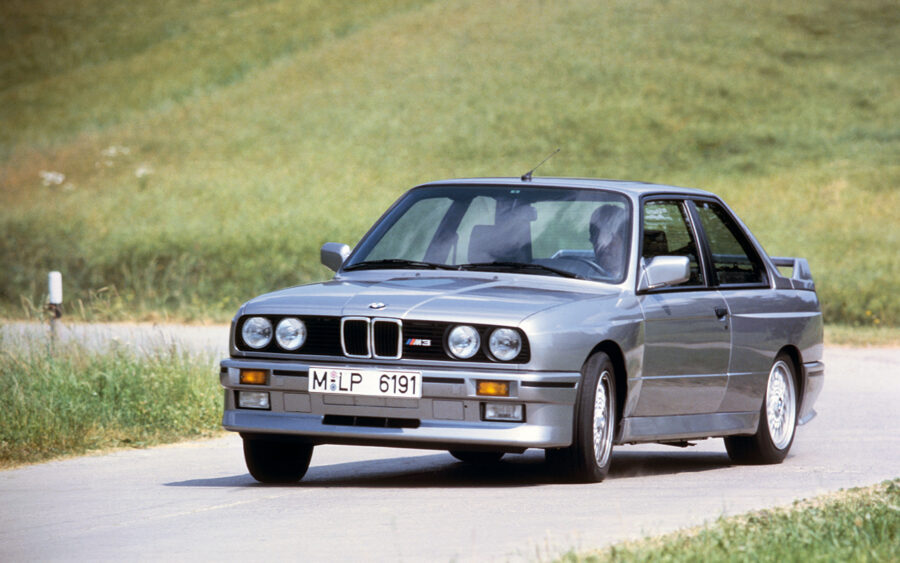
1986
Chrome deleted around doors and windows ahead of major facelift.
M3 on sale. Demand soon outstrips supply and capacity
325i Convertible now on sale in the UK.
325i Sport arrives for UK market late this year, complete with M3-aping (but not identical) M Technic (M-Tech) I optional body kit, interior parts, BBS wheels, suspension and limited-slip differential. SE package also offered for 320i/325i.
Left-hand-drive 325iX on sale in UK; approximately 12 converted to right-hand-drive in period.
New Zealand produces M325i special edition [100 units] for the home market, broadly similar to the UK 325i Sport.
1987
Major facelift for the E30: plastic bumpers, bigger tail lights, reshaped rear arches and rear valance, new front apron and ellipsoid headlights. Engine management upgrades for the six-cylinder models; M40 engine replaces the M10 variant of the 318i. Convertible continues as a pre-facelift.
Max Reisböck’s estate design enters production as the Touring, initially as a 325i.
Europe-only turbodiesel – the 324td (M21) – enters production.
215bhp ‘Evolution I’ M3 released for 1987 only; 505 cars built. Larger, 16-inch wheels, thinner rear and side window glass, a lighter boot lid, a deeper front splitter, and an additional rear spoiler complete the package. Catalysed and non-catalysed 195bhp production continues.
Special Italian tax-break special model, the 320iS, goes on sale, using a 2.0-litre variant of the M3’s S14 four-cylinder engine, known as the ‘Small M3’ or ‘Italo-M3’.
E30-based Z1 roadster shown at IAA Frankfurt to a rapturous reception. Karosserie Baur produces its last Baur-Kohl coupe, and ends development of its own E30 based roadster, the TC3, upon hearing of the Z1.
Eight electric 325iXs, converted to front-wheel drive, are produced as part of a battery-powered experimental program.
1988
UK sales of the Touring begin, available as 316, 318, 320 and 325 models.
Carburetted 316 finally replaced with the new, smaller engined M40 variant, the 316i.
Revised 325i Sport for UK market arrives (with accompanying M-Tech II body kit and interior options).
325iX models available in Europe as Tourings.
220bhp ‘Evolution II’ M3 released for 1988 only. 501 cars built.
‘Europa Meister ‘88 (European Champion ’88) M3 special edition released (148 units)
M3 Convertible production starts; as per the Convertible’s appearance, they are pre-facelift cars.
Catalysed, US market M3s go on sale.
Belgian and French importers produce their own ‘325iS’: a modified 325i with a close-ratio gearbox, limited-slip differential, and other choice options.
US market receives the all-wheel-drive 325iX.
E30-based, left-hand-drive only Z1 goes on sale in October.
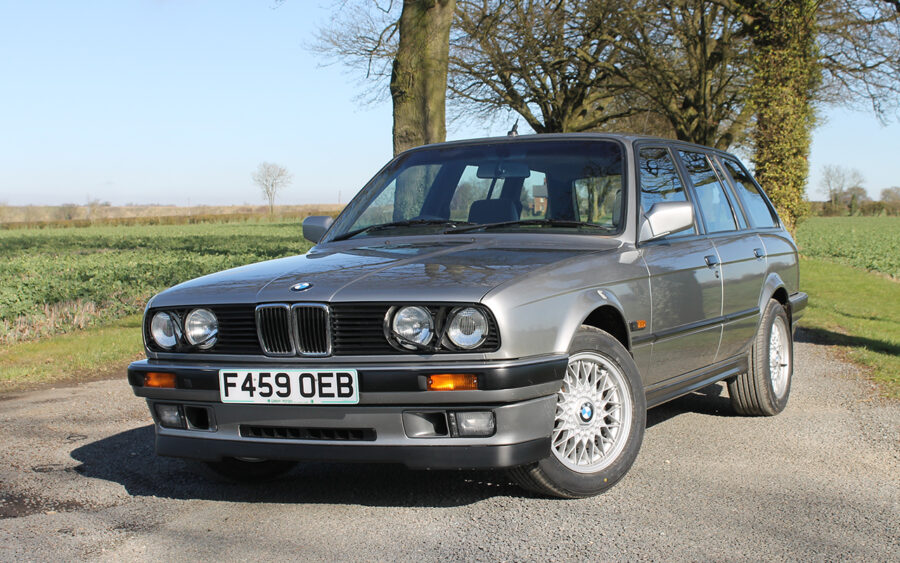
1989
M42-engined, 143bhp, 16-valve 318is arrives as a VW Golf GTI 16v alternative.
215bhp, 2.3-litre engine becomes standard on the M3, with production of the 195bhp cars ending this year.
2.5-litre, 235bhp ‘Sport Evolution’ M3 unveiled in December.
Limited edition, catalysed, 215bhp ‘Roberto Ravaglia’ [25 cars] and ‘Johnny Cecotto’ [480 cars] Edition M3s produced.
BMW South Africa creates the 325iS, equivalent to the UK-market 325i Sport.
1990
E30 production begins to wind down in Germany as the E36 coupe (actually designated a coupe) begins to take over in September. All lines still available.
318iS arrives in right-hand drive.
More luxurious 316i/318i Lux models go on sale in UK in February.
‘Sport Evolution’ M3 production ends in March after 600 units.
Standard E30 M3 production ends in December.
197bhp South African homologation special 325iS Evo I arrives to fight Opel Kadett in local Stannic Group N (Group A) racing. Aluminium alloy bonnet, door skins and front wings. Front suspension and rear brakes from the M3, and a 2.7-litre Alpina-derived engine, E28 five-lug hubs, upgraded springs, dampers and anti-roll bars, a Sport interior, and a limited-slip diff.
Z1 production ends.
1991
Two- and four-door saloon production ends in Germany, in April, with Convertible and Touring models continuing until the E36 is ready to replace them.
208bhp, 2.7-litre South African 325iS Performance HP (Evo II) introduced as a homologation response to the Opel Kadett 16v SuperBoss.
1993
E30 Convertible production ends in April.
South African 325is Performance HP wins that year’s Group N (Group A) production car championship outright, giving the E30 series one of its last race victories as an incumbent model.
1994
Final E30 Touring leaves the line.

